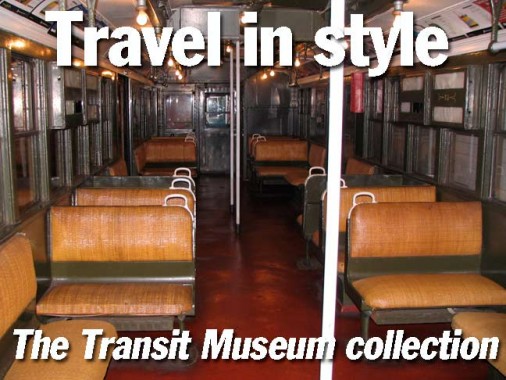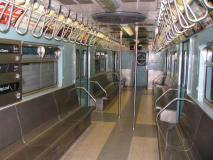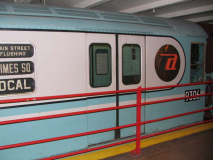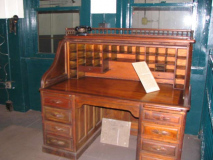I have been a member of the NYC Transit Museum for at least the past decade. I don’t visit all that often, admittedly, but I annually contribute $50 (up from $40 in 2013) to make sure it stays in existence and can keep mounting exhibits of the now 110-year old [in 2014] NYC subway. The Museum also sponsors tours of the system in which selected cars from its comprehensive collection are rolled out into service. (It’s always been a desire of mine to do a Transit-Museum-sponsored Forgotten NY tour in which I would get to wear the iconic orange reflective jacket.) For the past two Januarys, I have formed teams to compete in the Transit Museum Trivia Challenge; the first year our team lost by a point, the second year we won going away.
The Museum is located in the best-maintained abandoned station in the system, the IND Court Street station. When it was in passenger service from 1936-1946 it was a shuttle terminal, with the tracks connected to the IND 8th Avenue Line (A, C) and IND Crosstown Line (G) at the Hoyt-Schermerhorn station. When in service the shuttle had the designation HH. The platform was in use again from 1959-1981 as the western terminal of the Aqueduct Special, and it has often been used by motion picture producers who wanted an authentic appearance of a NYC subway station.
After the shuttle platform was shuttered for little passenger use in 1946, it was revived again in 1959 to get Brooklyn racing fans to Aqueduct Raceway via an express service. The lower deck of the IND platform at 42nd Street, now destroyed because of excavations for the #7 Flushing Line westward extension, was also used as a terminal for Manhattan railbirds. The Court Street platform was used for Aqueduct Specials until 1981. On July 4th, 1976, Court Street began its career as the home of the NYC Transit Museum, originally slated to be a temporary exhibit, but it never closed, and has now been established as permanent, with upkeep largely done through member contributions, public funding, museum store sales, individual donations, and public admissions.
[Thanks Joe Brennan’s Abandoned Stations site, a FNY reference mainstay since the beginning.]
In September 2009, I visited the museum collection and got what I think is a fairly comprehensive look …
R-33 car #9306 was built in 1963, entering service in September of that year on the #7 Flushing Line. These cars were originally painted light blue and white, a combination that came to be called “World’s Fair colors.” In addition, several US States mounted exhibitions at the Fair and their names were painted along the sides of several cars. They were painted gray and blue during the height of the graffiti era, and some cars were later painted pure white in a misguided effort to counter graffiti artists. After the MTA mounted an aggressive anti-graffiti campaign R-33 and R-36 cars on several IRT lines were painted maroon red, earning the nickname “redbirds.” All R-33s and R-36s were phased out of service in the early 2000s. A very few R-33s and R-36s sported a forest green paint scheme.
Former dispatchers’ office, with a board showing the Court Street track interlocking scheme, and an old-fashioned oak desk.

A word to the wise. The Independent Subway System, built between 1925 and 1950, was the first subway system devised by and run by the city government of New York City. It was the first subway system in NYC to display a uniformity of station construction and signage.
The use of the Standard and Helvetica fonts in the Unimark signage system adopted by the city in the 1960s is well-documented. Less so is the proprietary font devised for use in the IND beginning with the 8th Avenue line, the first constructed and opened for service. The font is used on all station tablet signage as well as other signage as shown here. It’s not been used before or since; a type designer should really find out its availability and devise lowercase versions.
The Court Street center platform has several historic train cars lined up alongside. IND stations were known for overbuilding their mezzanines, which provides a large exhibit space.
The R-4 cars first made their appearance in the early 1930s. Originally equipped with bare bulbs for lighting the interior (that featured left-hand screws so they could not be used for home lighting, discouraging thieves) the R4s were essentially the same as the R1s, the first cars produced for the IND. (By all accounts I’ve seen, the “R” stands for “revenue,” as in cars that were in passenger service.) In the 1940s, the bare bulbs were replaced by “bullseye” lighting as seen here, so-called because of the fluted glass diffusers. In the 50s, wicker seats gave way to red cushion seating that did nothing to discourage vandals, bringing on the era of plastic benching.
The “Subway Sun” ad dates to 1951, the 6th anniversary of the United Nations.
More words to the wise. When the sign was produced, the subway was one of the few places you couldn’t smoke. Spitting is still an issue; in many immigrant cultures, spitting is considered necessary to eject poisons from the system.
A recent strategy devised by the MTA involves removing trash bins from platforms, hoping the reverse psychology will cause New Yorkers to carry trash with them out of the subway system and deposit it elsewhere. My expectation is that the tracks will get even grimier than they already are.
R-15 cars, with their distinctive “porthole” door windows, were introduced in 1950 and ran on the Flushing Line until their replacement by the R-33/36 “World’s Fair” cars. They would run on other IRT lines until 1984 when they were supplanted by the R-62 line. In later years, they could be coupled with cars from other series. This R-15 car, Number 6239, is the only one remaining. Note the red cushion seats. Vandals had just as much of a grand time with these as they did with wicker seats, and by the 1960s, the Transit Authority turned to molded plastic.
The R-1 was the first car used on the new 8th Avenue IND subway in 1932. The most innovative feature of the new cars was the four sets of double doors on each side, which permitted faster loading and unloading of passengers. The cars were 60 feet long and had 60 seats. In those days manufacturers were still building seats in subway cars in both crosswise and facing patterns. The cars were painted a somber dark green, though wicker seats and white porcelain handholds livened things up. It was during this era that Duke Ellington’s swing classic “Take the A Train” was written.
R-12 cars began service on the #7 Flushing Line in 1948 and like the R-15s, they were used there till 1963 when the R-33/36s supplanted them. The cars also had the distinction of being the last cars used on the #8 train, and you are excused if you were not aware that that was the designation of the Bronx Third Avenue El, where they ran from 1969 until the closure of the line in 1973. They also saw service on other IRT lines, including the former Bowling Green Shuttle, until their retirement in 1981. R-12s were among the last new cars that had wicker seating installed. In later years, of course, gray plastic was used.
D-Type Triplex cars were introduced in 1927, before the “R” designation was employed, and ran originally on the BMT 4th Avenue Line (R train) to Bay Ridge, though they later saw a lot of service on the Sea Beach (N train) and Brighton (B/Q trains). Before their retirement in 1965 they served on all Southern Division BMT lines, or trains going to Bay Ridge or Coney Island. D-Type Triplexes were the first train cars to carry roll signs with route designations on the lead car. On the BMT, the lines were originally numbered from #1 to #16. A lighting system also showed whether the train was using the tunnel or the Manhattan Bridge.
The name “Triplex” describes the trainsets, since they consist of three car body sections that are carried on four trucks.
The BRT, or Brooklyn Rapid Transit, was the precursor of the BMT, or Brooklyn-Manhattan Transit. Developed to be used in new subway routes built under the Dual Contracts subway funding project of 1911, the BRT developed its Standard car in 1916, using Boston Elevated cars as its model. These cars were the first to be made of steel instead of wood. The cars contained 78 seats, many more than the main competitor at the time, the IRT, which could seat 44 people per car. Altogether, with standees, each car could hold up to 180 people. These were also the first cars that could be entered via pneumatically-controlled doors in the center of the car. By 1921, a conductor could open all doors in every car at the same time, also a first.
The R-11, developed in 1949, was called the “Million Dollar Train” because each car cost $100,000 and most NYC subway lines accommodate ten cars. They were originally scheduled for use in the Second Avenue Subway, which had been under consideration since 1920. The cars boasted new technologies such as lighting that supposedly combatted bacteria, and ceiling vents that expelled stale air. Doors were controlled electronically. The ten R-11 consists that had been produced were rebuilt and streamlined further in 1965 and redesignated as the R-34 line. However, repairing the cars proved difficult as they used unique parts that were not found in other subway cars, and subsequently they were retired in 1977. The car at the Transit Museum is the only remaining one.
It was the first subway car with a stainless steel exterior and as such, was the precursor of the familiar corrugated R-32 cars that are still in use on the 8th Avenue line (and lately, the Nassau-Jamaica line)
The R-16 entered passenger service in 1955 on the Nassau Street-Jamaica line, or the J train. They were also the first subway cars to see service on the new line to the Rockaway peninsula in June 1956. These cars set the tone for subway car design until the late 1960s when the R-40s, with their slanted ends, were introduced. The design included the rollsign boxes that replaced some windows, a familiar feature until the 1970s. The R-16s remained in service on the M train until 1987.
There have been many generations of system maps in use. Until system unification in 1940, all three subway companies produced their own maps and since they competed against the other, not much effort was made to acknowledge the other two systems from the one shown by the map. In the 1940s the Hagstrom Company produced some handsome maps showing the complete system, and the map produced by Unimark’s Massimo Vignelli in the 1970s is still widely considered the king of subway maps through the decades. The MTA still employs it in phone apps.
The map posted here in the R-16 car was produced by the NYC Transit Authority and used in 1959. Note the still-existing Bronx 3rd Avenue el and Brooklyn’s Myrtle Avenue el.
I’m familiar with the R-30 car from its frequent use on the BMT 4th Avenue line in the 1960s and 70s, with its pink plastic seats. This is the subway car John Travolta rode to Manhattan after winning the dance contest in Saturday Night Fever, but handed it to the Latino couple. The cars were also used in Carlito’s Way, Die Hard with a Vengeance, and Money Train. The cars were produced in 1962 and 1963 and were replaced on the BMT 4th Avenue by the R-46s, with their familiar orange and yellow interiors and “ding dong doors.”
Car 4902 was part of the IRT’s “Lo-V” or Low Voltage line and was built in 1917.
Earlier Composite and “Hi-V” (High Voltage) equipment that ran on the IRT had utilized a 600 volt DC circuit that ran directly through the motorman’s master controller to control the car’s propulsion. The 600 volts was also trainlined through the whole train by the use of high voltage jumper cables which had to be run between cars. However, Lo-V equipment used battery voltage (32 volts) in the motor control circuit to move high voltage (600 volt) contacts underneath the car, which would control the car’s propulsion. Likewise, it would no longer be necessary to use 600 volt jumpers between the cars. This tremendously improved safety of the equipment for both train crews and shop personnel alike. wikipedia
The narrowness of IRT cars is easily seen here, in comparison to early BMT Triplexes.
A contemporary IRT system map is mounted in the car. In 1917 the IRT operated the original subway, built in 1904 from City Hall to 145th Street, as well as the 2nd, 3rd, 6th and 9th Avenue Els, as well as subway and el extensions in the Bronx and Brooklyn.
I’ll let the Branford Electric Railway Association describe the next two venerable cars:
One of the well-known trio of wooden cars that has travelled the New York subway system periodically for the past 25 years, Car 1404 has led a strange and eventful life. For the first three decades of its life [beginning in 1907] it operated in essentially the configuration it is currently in – an open-platform wood car. But in the late 1930’s, to modernize the fleet serving the Corona/Flushing line for the 1939 World’s Fair, BMT decided to rebuild 90 of its old elevated cars into 30 semi-permanently mated three-car sets known as “Q” (for “Queens”) cars. This involved enclosing the cars’ platforms, installing quarter-point side doors, and reworking the control systems so that each set functioned in a motor/trailer/motor fashion. Car 1404 was rebuilt thusly and became the “C” car of set 1603. In 1950, the “Q” fleet was transferred to the Third Avenue Elevated and lighter-weight trucks from IRT composite cars were fitted to 1603C and the other end (motor) cars. The final change to the appearance of the “Q” fleet came in 1957, when they were transferred to the Myrtle Avenue Line and their railroad roofs were lowered in height so that they could make it through the subway to the Coney Island shop complex. Retired in the late 1960’s along with the other “Q” types, set 1603 was chosen for preservation and operated on fantrips during the 1970’s. In 1979 it was decided that the three cars in set 1603 would be rebuilt to original as-built condition. This was done, but incompletely; the cars retained their 1957 lowered roofs and 1950 lightweight trucks. Since 1979 car 1404, plus the other two cars from “Q” set 1603, has been on display at NYTM and has occasionally run in fantrip service. Branford Electric Railway Association
The best-preserved example of a BMT “Q” type rapid transit car is 1612C, preserved in the only rail museum in the country actually situated in a disused subway station, NYTM. This car was built as a single-unit, open-platform wooden elevated car for service [in 1908] on the BRT, and for the first three decades of its life it operated as such. In the late 1930’s, to modernize the fleet serving the Corona/Flushing line for the 1939 World’s Fair, BMT decided to rebuild 90 of its old elevated cars into 30 semi-permanently mated three-car sets known as “Q” (for “Queens”) cars. This involved enclosing the cars’ platforms, installing quarter-point side doors, and reworking the control systems so that each set functioned in a motor/trailer/motor fashion. In 1950, the “Q” fleet was transferred to the Third Avenue Elevated and lighter-weight trucks from IRT composite cars were fitted to 1612C and the other end (motor) cars. The final change to the appearance of these cars came in 1957, when they were transferred to the Myrtle Avenue Elevated and their railroad roofs were lowered in height so that they could make it through the subway to the Coney Island shop complex. Retired from passenger service in the late 1960’s along with the other “Q” types, 1612C was first designated for work service as alcohol sprayer 30504. Then in the late 1970’s, when preserved “Q” set 1622ABC was rebuilt to open platform configuration, 1612C/30504 (sans the other two cars in its set) was repainted to its c1940 livery (though still retaining its c1950 trucks and c1957 roof profile) and placed in the NYTM where it has remained on display for over a quarter century. Branford Electric Railway Association
Once again, some of the eminently legible IND-type signage found in the Transit Museum Court Street platform. The only remaining examples of this font can be found on wall identification on subway stations formerly part of the IND system. Other have been replaced by white on black signs using the Helvetica font. Once again, if anyone knows the name of this proprietary IND font, let me know.
Roll sign found in early IND cars such as the R-1. Oddly the FF designation was never used. In the old IND nomenclature, trains that ran express were single letters while local trains on the same line were double, thus, the A was the 8th Avenue express, while the AA was the local. However, trains that were express with sections where they ran local were single letters, thus the E and F trains. (The EE ran as a local line on the BMT from Whitehall to 71st/Continental between 1967-1976, an odd use of an IND latter on a BMT line).
Before kicking it in the head for today’s page, here’s the cavernous Court St. mezzanine, now used for Museum exhibit space.
5/18/14




